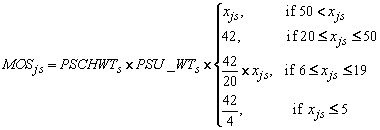- Surveys & Programs
- Data & Tools
- Fast Facts
- News & Events
- Publications & Products
- About Us
NAEP Technical DocumentationSampling of Private Schools for the 2012 Economics Assessment
In the design of each school sample, five objectives underlie the process of determining the probability of selection for each school and how many students are to be sampled from each selected school containing twelfth-grade students:
to meet the target student sample size;
to select an equal-probability sample of students;
to limit the number of students who are selected from a school;
to ensure that the sample within a school does not include a very high percentage of the students in the school, unless all students are included; and
to reduce the rate of sampling of small schools, in recognition of the greater cost and burden per student of conducting assessments in such schools.
The goal in determining the school's measure of size is to optimize across the last four objectives in terms of maintaining the accuracy of estimates and the cost-effectiveness of the sample design.
Therefore, to meet the target student sample size objective and achieve a reasonable compromise among the other four objectives, the following algorithm was used to assign a measure of size to each school based on its twelfth-grade enrollment as indicated on the sampling frame.
The measures of size vary by enrollment size. The preliminary measures of size (MOSjs) were set as follows:

where xjs is the estimated twelfth-grade enrollment (j = 12) in school s, PSCHWTs = the PSS area frame weight for school s, computed by the U.S. Census Bureau, and PSU_WTs = the PSU weight for school s.
The next task in this development is to describe bj, the constant of proportionality. It is a sampling parameter that, when multiplied with a school’s preliminary measure of size (MOSjs), yields the school’s final measure of size. It is computed in such a way that, when used with the systematic sampling procedure, the target student sample size is achieved. For private schools, this parameter varied by private school affiliation (Catholic, non-Catholic, and unknown affiliation).
The final measure of size, Ejs, is defined as:
![]()
The quantity uj (the maximum number of “hits” allowed) in this formula is designed to put an upper bound on the burden for the sampled schools. For private schools, uj is 1.
For the NAEP 2012 samples, by design a school could not be selected, or "hit," in the sampling process more than once. In addition, an adjustment was made to the preliminary measures of size in the sample to attempt to reduce school burden by minimizing the number of schools selected for simultaneous administration of both the economics assessment and the long-term trend (LTT) assessment. The NAEP 2012 studies used an adaptation of the Keyfitz process to compute conditional measures of size that, by their design, minimized the overlap of schools selected for both the NAEP economics assessment and the LTT assessment.
Schools were ordered within each jurisdiction using the serpentine sort described under the stratification of private schools. A systematic sample was then drawn using this serpentine sorted list and the measures of size. Ninety-five private schools were selected for the twelfth-grade economics assessment.
Last updated 05 June 2013 (JL)